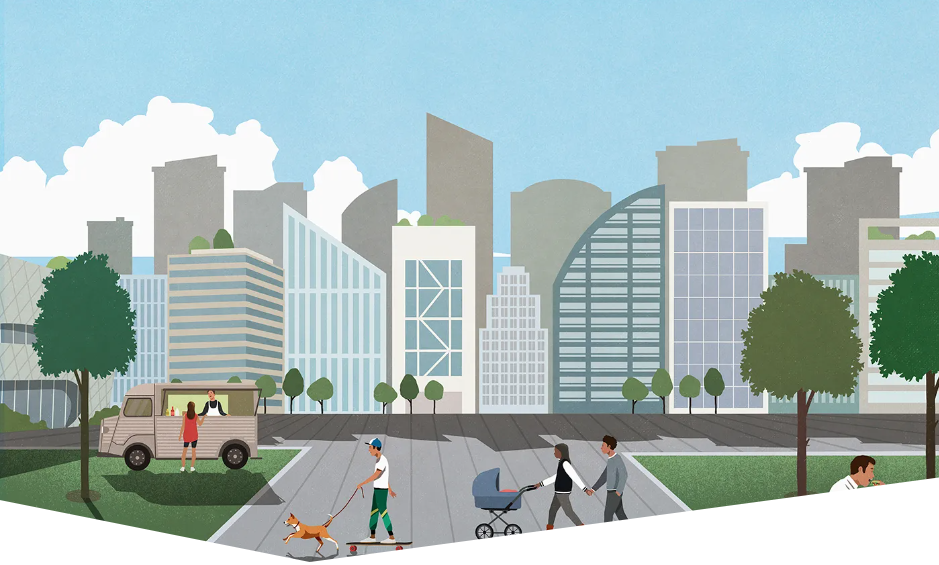As Canada continues to grapple with a housing crisis rooted in a persistent inventory shortage, RE/MAX Canada explores possible solutions through the idea of walkable neighbourhoods.
Thus far, the National Housing Strategy announced in 2017 has succeeded in creating and repairing 213,733 units. In comparison, Canada’s population grew by more than one million in 2022. With demand perpetually housing outpacing supply, many Canadians find themselves at a fork in the road where difficult choices must be made, but what is the reality of those choices?
This new report focuses on walkable neighbourhoods as an urban planning concept that puts daily necessities within a walk, bicycle ride or transit ride from home. RE/MAX highlights this concept as a pragmatic approach to building the right supply of housing for the greatest number of Canadians, in a way that delivers maximum liveability and affordability – particularly in smaller municipalities that are experiencing rapid growth.

WALKABLE NEIGHBOURHOODS:
Lessons for Small Communities
Canada has a housing crisis. While the problem of a chronic lack of supply is almost unanimously accepted, the solution remains a bone of contention among governments, businesses, academics, and area experts, as well as Canadians.
First, let’s focus on what everyone agrees upon. The country and its three levels of government need to implement a housing strategy that will significantly and expediently build more homes across all markets, large and small. This seems simple and logical – build more homes to create a better, more sustained balance between supply and demand, and greater accessibility and affordability will return to the market. Not so fast. There are unintended consequences tied to this seemingly simple equation. Even in its most basic iteration, the plan to build millions of new housing units over the next decade, as governments have promised, is easier said than done. At this level of strategizing, Canada needs a robust and ready labour force to realize this ambitious level of inventory. We currently don’t, and while this could change, especially given the recent news of Canada’s new immigration program to address labour shortages – the fields of construction and trades are suffering some of the most chronic shortages effect. Canada needs to invest in new soft and hard infrastructure, while protecting existing green infrastructure (wetlands, grasslands, forests), to ensure new housing supply can serve) the growing population (e.g., utilities, sewage, etc.), while also mitigating against the huge risks associated with climate change and extreme weather (e.g., flooding, wildfires and extreme heat). Canada needs to guarantee that new housing stock is affordable by ensuring that a percentage of the inventory is subsidized, open to non-equity co-op type properties and diversified across building types, to avoid the perils of gentrification. Canada needs to rethink our streetscapes, to bring greater diversity across our modes of transportation, including public transit, biking, walking and driving.

While adding more inventory is important, it’s more complex than that. More housing is needed within existing neighbourhoods to take advantage of existing infrastructure and services and bring more stability to the tax base to maintain them. A home is more than just a commodity that is evaluated by its square footage – a concept that RE/MAX Canada has been advocating for more than five years. “Home” lies within a dynamic neighbourhood that delivers an emotional return based on the quality-of-life expectations and aspirations of its residents. Without schools, libraries, small businesses, enterprise and green space, as well as accessible and diversified transportation, the home becomes empty inventory. So, while the majority will agree that Canada needs to invest in more housing in the next decade (and fast), the solution to the housing crisis is also about building the right kind of homes within the context of the wider neighbourhood, its socioeconomic diversity, and the changing climate as a constant potential disruptor. It is for these critical reasons that RE/MAX Canada created this report. In collaboration with expert contributors spanning urban design, climate adaptation and mitigation, and transportation, the concept of the walkable neighbourhood may well be the most pragmatic strategy to build the right kind of housing supply to serve the greatest number of Canadians, in a way that delivers maximum liveability and affordability.
45% OF DRIVERS AND 59% OF NON-DRIVERS AGREE THAT THE WALKABLE NEIGHBOURHOOD IS REALISTIC, ACHIEVABLE AND FEASIBLE
Showing their level-headed pragmatism, of the more than 50 per cent who disagreed with the dual benefits of a walkable neighbourhood concept, their worry could spark gentrification – a very legitimate concern, should mixed-use and subsidized housing not be front and centre in the strategy. Indeed, across traffic pain points, commuting times and a desire for a higher quality of living within the communities’ people live, survey respondents feel the walkable neighbourhood is realistic, achievable and feasible.
Here we see a community with predominantly monoculture inventory. Done right, densification should be adversity of building types. Ultimately, increasing supply of “missing middle” housing instead of only focusing on single family detached and semi detached properties.
Look for these elements: semi-detached housing, different types of buildings (high, medium, low rise), local church, public transit, bike lanes, accessible sidewalks, public gardens.
